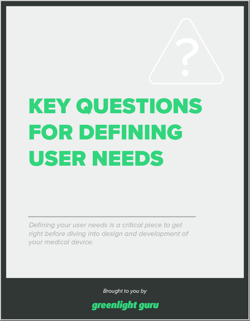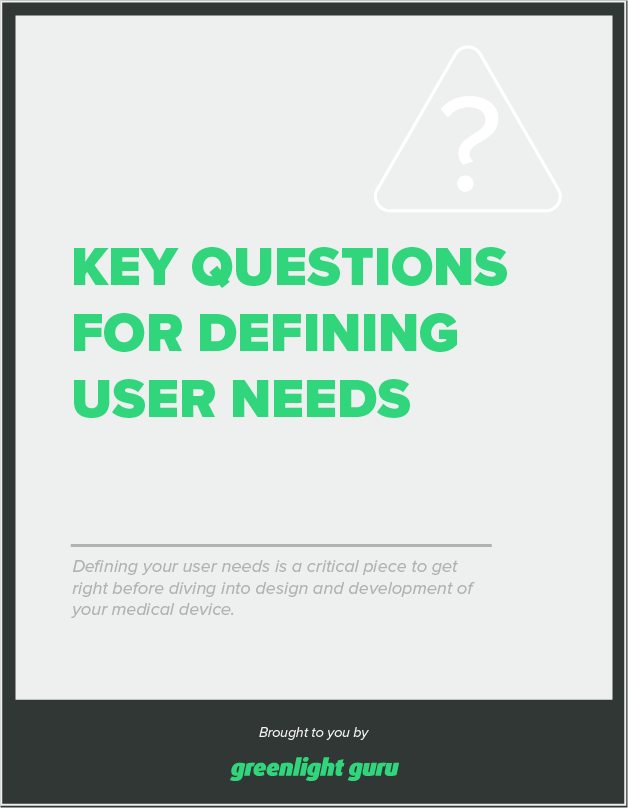
Every medical device begins with the same purpose—to improve the quality of life by meeting the needs of its users.
User needs give developers a first-hand look into the customer perspective. With this kind of insight, medical device companies are able to produce devices that are both more effective and more accessible to patient populations.
But, despite being the first step in the design control process, the FDA doesn’t provide much more instruction on user needs or how to define them. The closest thing we get is this, from CFR 820.30 (g):
Design validation shall ensure that devices conform to defined user needs and intended uses and shall include testing of production units under actual or simulated use conditions.
So how exactly should you define user needs for a device, especially as they pertain to design controls? Let’s take a closer look at some essential steps.
FREE DOWNLOAD: Click here to download our guide to 10 key questions for defining user needs.
Identify high-level user needs with the right questions
Before you begin defining user needs, it’s important to make sure you have a thorough understanding of the problem you are trying to solve. In other words, don’t start with what your product does; start with who it’s for.
As you think through your end user’s needs you may be able to identify key features and functionality that require deeper examination. Here are a few crucial questions to consider when identifying high-level requirements:
-
What clinical problem or need will it solve? This may seem obvious, but the needs of your users will define two critical definitions for your device: the intended use, or the general purpose of the device, and its indications for use—the medical conditions your device will help diagnose, treat, prevent, cure, or mitigate.
-
Who is going to use the device? Your user base may all suffer from the same condition or illness, but they also represent varied demographics and backgrounds. User needs should identify basic factors such as age or related medical conditions, as well as more nuanced details like mobility level or access to care. Considering these mitigating factors may prevent design teams from precluding key populations from using your device.
-
Will it be used once or repeatedly? The choice of disposable or multi-use plays a significant role in user needs relating to packaging and labeling. Disposable products are used only once, and user needs involve pre-sterilization and any packaging used for its safe disposal. Multi-use devices require reprocessing before its next use, and users will require the labeling to make these steps clear.
-
Where will the device be used? With more medical devices being designed for home-use, it’s a great idea to identify the environments and conditions in which your device will be used. Can your device be used in a non-sterile facility? Will it be linked with a smartphone app? Are there any issues with power supply or outages?
-
How will the user interact with the device? User interface (UI) is a big deal in how well a device performs. As a part of usability, you should consider the numerous components with which users interact while preparing the device for use (e.g., unpacking, set up, calibration), using the device, or performing maintenance (e.g., cleaning, replacing a battery, making repairs).
Remember to document these answers! The purpose of these questions serve as great starting points for not only your user needs, but the design inputs they will eventually become.
Capture the voice of the customer with user needs research
User needs can be captured in a variety of ways. In some instances, this may be a candid conversation with someone close to the clinical problem you want to solve, such as a doctor or surgeon.
However, this is only a starting point. Medical devices should never be built with only one person’s opinion in mind, nor should you ever assume you already know the needs of users.
Instead, you’ll want to pursue formalized research methods that properly document user needs as part of the design control process.
There are a few common approaches to user needs research:
-
Observational techniques like job shadowing and ethnography, in which you spend significant time with device users.
-
Interviewing techniques like individual patient interviews or focus groups, in which you ask survey questions directly to end-users.
-
Usability techniques like contextual inquiries or cognitive walkthroughs, in which you ask users to perform specific tasks and ask questions along the way.
-
Market research techniques like competitive analysis of similar products, in which you study existing devices to identify user needs in your own device.
It’s common and good practice to combine approaches as a way to fully capture the voice of the customer.
One thing to keep in mind is that users may not be able to fully articulate needs, particularly if they’re not trained medical professionals. That’s okay! Part of our job as medical device developers is to talk it through with them and identify the core problem statement.
When in doubt, there are 3 easy questions you can rely on to find insight into their thoughts:
-
What are you doing?
-
Why are you doing it like that?
-
Would it be better if you could do it like this?
Translate the user needs into design inputs
Once you’ve finished your research portion and have gathered your user needs, it’s time to bridge those findings into design inputs. While user needs may be vague or fuzzy, design inputs are specific and actionable.
In the context of design controls, your inputs are intended to capture all functional, performance, safety, and regulatory requirements in a way that builds them upon user requirements.
For instance, if a user need states that “the device must be portable,” what exactly does that mean in engineering terms? What does that mean for its power supply or online connection? What might it mean for the weight, shape, or size of the device?
When translating user needs into design inputs, your objectives should be to:
-
Capture all functional, performance, safety, and regulatory requirements.
-
Build upon user needs and intended use.
-
Make sure design inputs are clear and objective.
-
State design inputs in a way that allows you to prove / disprove them.
The last point is key, as you’ll eventually need to validate your design inputs, a task for which your user needs will serve as a great resource.
FREE DOWNLOAD: Click here to download our guide to 10 key questions for defining user needs.
Connect every user need and design control with Greenlight Guru
Defining your user needs is an essential step to creating effective and successful devices. Not only does it guide your product development, it also is a foundational step in the FDA’s requirements for design controls.
With so much at stake, you need a solution to manage your complex medical devices in a design control matrix that provides traceability and flexibility. That’s where Greenlight Guru comes in.
Greenlight Guru Design Control Software
Our end-to-end solution streamlines product development, quality management, and clinical data management by integrating cross-functional teams, processes, and data throughout the entire product lifecycle.
Ready to learn more? Contact us today for a free personalized demo of Greenlight Guru →
Etienne Nichols is the Head of Industry Insights & Education at Greenlight Guru. As a Mechanical Engineer and Medical Device Guru, he specializes in simplifying complex ideas, teaching system integration, and connecting industry leaders. While hosting the Global Medical Device Podcast, Etienne has led over 200...
Related Posts
A Guide to Bridging User Needs Into Design Requirements
How to Define Your Design Inputs and Design Outputs
Best Practices for an Effective Medical Device Design Transfer Process
Get your free resource
10 Key Questions for Defining User Needs











